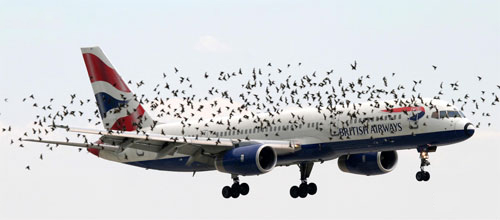
One of two avian radars located at SEA. This one is in a ditch adjacent to the third runway.
Have you ever looked up in the sky, seen a hawk or eagle soaring, and admired the beauty? Although exciting, the birds can cause major problems for aviation.
The ’œMiracle on the Hudson’ is a prime example of why birds and aircraft do not mix. But what do airports do to ensure that our journeys, from one airport to the next, are safe? I recently took a tour of Seattle-Tacoma International Airport (SEA) and saw what their wildlife management team was doing to keep both airplanes and birds safe.

A Snowy Owl is captured at SEA, then released in the upper part of Washington state, near Bellingham – Photo: SEA
SEA has been a leader in wildlife management since the 1970s, when they were the first airport to hire a dedicated wildlife biologist onto their staff. At the moment, Steve Osmek runs the wildlife program at the airport and has done so for a number of years. Previously coming from the USDA and NOAA, he gets to combine his love of animals and an interest in aviation into on job. It was Steve who took me around the airport and introduced me to a number of ways that the airport is helping to mitigate bird strikes.

Birds surround a British Airways Boeing 757 in Budapest. Photo by Adam Samu.
Introduction from David: This is the continuation of my guest’s (aka my mom) blog posted last week about birds and planes:
At the beginning of the 20th Century, Man began to take over the skies. Birds had dominated for millennia, but now planes started to usurp the atmosphere.
At first it didn’t seem a problem. Man and bird managed to share the airways. However, as planes became more predominant, birds became more of a hindrance to the flight of humans.
Collisions between birds and planes cause damage to the planes and on rare occasions, planes are downed. According to the FAA, twenty-three people have been killed and 209 injured by bird strikes. Not huge numbers. However the financial cost has been estimated at a total of $400 million. Of course the fatality to birds has been great. Since there are 5,000 bird strikes per year and 80% are not reported,many of our avian friends are lost. They have no chance when it comes to encountering a plane! Interestingly, the first bird strike was reported in 1905 by Orville Wright!
Since birds cannot solve this problem, it is up to Man to create a way for birds and planes to share the sky. Since the majority of strikes occur below 3,000 feet and during take-offs or landings, most of the research centers around airports, both civilian and military.
To discourage birds from hanging around airports, there have been experiments with electromagnets, ultrasonic devices, scarecrows and other predator effigies and noisemakers. None of these methods have been endorsed by the FAA. And even though there is still hope that someday there will be a “magic box” having to do with microwave alarms, the common wisdom as of now is much more simple.
According to Matt Klope, a civilian biologist at NAS Whidbey Island, “…the best management practice is to identify the problem species… and modify/alter the airfield habitats to encourage the birds to go somewhere else.” This stategy is also echoed by other experts.
In other words, birds need a habitat that includes, food, water, shelter and a place to raise their young. Birds are attracted to airports that provide some or all of these needs. Thus, if the airport eliminates them, the birds will leave.
So, airports need to minimize water at runway ends, close landfills and other food sources.If prey birds are discouraged from airports, predators won’t have food. An additional tactic is to introduce predators and dogs to keep the much more numerous prey birds away. Gulls and pigeons are the most common birds in strikes.
Airports also continue to experiment with random explosions and fireworks as well as gas cannons. As a birder, I am encouraged with the efforts to keep my feathered friends away from those huge metal avians. And I am realistic enough to concede that human life and financial considerations trump the lowly bird who once inspired Man.
Hopefully, Man will continue to find ways to keep these two fliers apart!
For more information:
* FAA
* USDA
* BLOG: Why don’t airlines put screens on engines for birds?
* Aubrey Cohen with the Seattle PI looks at dealing with birds at SEA
Image by Adam Samu via Airliners.net
Used with permission


